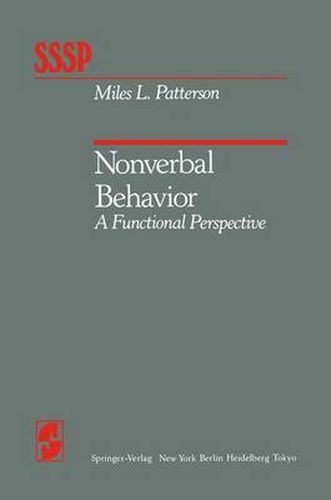Readings Newsletter
Become a Readings Member to make your shopping experience even easier.
Sign in or sign up for free!
You’re not far away from qualifying for FREE standard shipping within Australia
You’ve qualified for FREE standard shipping within Australia
The cart is loading…






This title is printed to order. This book may have been self-published. If so, we cannot guarantee the quality of the content. In the main most books will have gone through the editing process however some may not. We therefore suggest that you be aware of this before ordering this book. If in doubt check either the author or publisher’s details as we are unable to accept any returns unless they are faulty. Please contact us if you have any questions.
My interest in nonverbal behavior has remained constant for over 15 years. I think this has been the case because nonverbal behavior has proved a very fascinating and challenging topic. Others might suggest that I am just a slow learner. With enough time in any area, however, one begins to feel that he or she has some special insights to offer to others. About the time that I was struck with that thought, approximately two and a half years ago, I was developing the first version of my sequential functional model of nonverbal exchange. It seemed to me that the func tional model might provide a very useful framework for a book discussing and analyzing nonverbal behavior. I did not want (nor do I think I had the patience) to write a comprehensive review of research on nonverbal behavior. Other works, such as Siegman and Feldstein’s (1978) edited Nonverbal Behavior and Commu nication, and Harper, Wiens, and Matarazzo’s (1978) Nonverbal Communication: The State of the Art, have provided excellent reviews of the research on nonverbal behavior. Instead, what I have tried to do in this book is to use nonverbal behavior as a vehicle for discussing social behavior. In a very real sense, this analysis of nonverbal behavior is a means to an end, not an end in itself. A consequence of this approach is that this review is a selective one, unlike the comprehensive works mentioned earlier.
$9.00 standard shipping within Australia
FREE standard shipping within Australia for orders over $100.00
Express & International shipping calculated at checkout
Stock availability can be subject to change without notice. We recommend calling the shop or contacting our online team to check availability of low stock items. Please see our Shopping Online page for more details.
This title is printed to order. This book may have been self-published. If so, we cannot guarantee the quality of the content. In the main most books will have gone through the editing process however some may not. We therefore suggest that you be aware of this before ordering this book. If in doubt check either the author or publisher’s details as we are unable to accept any returns unless they are faulty. Please contact us if you have any questions.
My interest in nonverbal behavior has remained constant for over 15 years. I think this has been the case because nonverbal behavior has proved a very fascinating and challenging topic. Others might suggest that I am just a slow learner. With enough time in any area, however, one begins to feel that he or she has some special insights to offer to others. About the time that I was struck with that thought, approximately two and a half years ago, I was developing the first version of my sequential functional model of nonverbal exchange. It seemed to me that the func tional model might provide a very useful framework for a book discussing and analyzing nonverbal behavior. I did not want (nor do I think I had the patience) to write a comprehensive review of research on nonverbal behavior. Other works, such as Siegman and Feldstein’s (1978) edited Nonverbal Behavior and Commu nication, and Harper, Wiens, and Matarazzo’s (1978) Nonverbal Communication: The State of the Art, have provided excellent reviews of the research on nonverbal behavior. Instead, what I have tried to do in this book is to use nonverbal behavior as a vehicle for discussing social behavior. In a very real sense, this analysis of nonverbal behavior is a means to an end, not an end in itself. A consequence of this approach is that this review is a selective one, unlike the comprehensive works mentioned earlier.